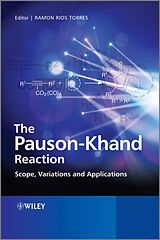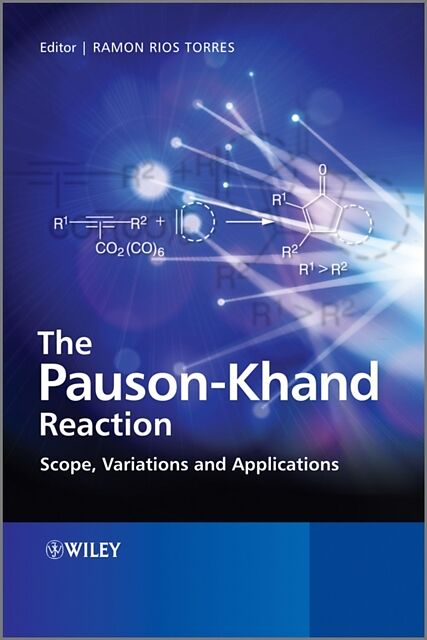The Pauson-Khand Reaction
Einband:
Fester Einband
EAN:
9780470970768
Untertitel:
Scope, Variations and Applications
Genre:
Chemie
Autor:
Rios Torres Ramon
Herausgeber:
Wiley-Blackwell
Auflage:
1. Auflage
Anzahl Seiten:
336
Erscheinungsdatum:
13.04.2012
ISBN:
978-0-470-97076-8
Informationen zum Autor Professor Ramon Rios Torres, Dept Química Orgànica, Universitat de Barcelona, Spain Ramon Rios Torres was born in 1974 in Barcelona. He obtained his PhD under the supervision of Professor Albert Moyano in 2000 at the University of Barcelona, and undertook postdoctoral work with Professor P. J. Walsh at Pennsylvania University, Professor Benjamin List at Max Plank Institute, Armando Cordova at Stockholm University and Professor Alvarez-Pez at Granada, and an industrial experience at J.C. Uriach (Spain). He received an ICREA position as independent researcher in 2008 at University of Barcelona. His research interests are devoted to the discovery of new asymmetric methodologies and their applications to organic synthesis.?He is author or coauthor of more than 60 papers, 11 book chapters and 1 patent. Klappentext The Pauson-Khand reaction is an important reaction in the field of organic chemistry. It involves the transition-metal catalysed cycloaddition of an alkyne, an alkene and carbon monoxide, to produce cyclopentenones. The importance of this reaction originates from its high value in transforming simple components into the synthetically useful cyclopentenone unit, in which a high degree of molecular complexity can be achieved in a single step, with impressive stereochemical and regiochemical control.The Pauson-Khand Reaction investigates the nature and many variations of this reaction.Topics covered include:* the mechanisms of Pauson Zusammenfassung The Pauson-Khand reaction is an important reaction in the field of organic chemistry. It involves the transition-metal catalysed cycloaddition of an alkyne, an alkene and carbon monoxide, to produce cyclopentenones. The importance of this reaction originates from its high value in transforming simple components into the synthetically useful cyclopentenone unit, in which a high degree of molecular complexity can be achieved in a single step, with impressive stereochemical and regiochemical control.The Pauson-Khand Reaction investigates the nature and many variations of this reaction.Topics covered include:* the mechanisms of Pauson Inhaltsverzeichnis List of Contributors xiForeword xiiiPreface xv1. The Pauson-Khand Reaction - an Introduction 1William J. Kerr1.1 The Discovery and Early Evolution of the Khand Reaction 11.2 The Intermolecular Pauson-Khand Reaction 41.2.1 Regioselectivity of Alkyne Insertion 51.2.2 Regioselectivity of Alkene Insertion 61.3 The Intramolecular Pauson-Khand Reaction 81.4 Enhancing the Pauson-Khand Annulation by Reaction Promotion 91.4.1 Dry State Adsorption 91.4.2 Ultrasound Techniques 101.4.3 Microwave Promotion 101.4.4 Amine N-Oxide Additives 111.4.5 Sulfide Promoters 131.5 Catalytic Pauson-Khand Protocols 151.6 Concluding Remarks 16Acknowledgements 17References 172. The Mechanism of the Pauson-Khand Reaction: Hypothesis, Experimental Facts, and Theoretical Investigations 23Xacobe C. Cambeiro and Miquel A. Pericás2.1 Introduction 232.2 Stoichiometric Pauson-Khand Reaction 252.2.1 The Ligand Substitution Steps 252.2.2 Cobaltacycle Formation 292.2.3 CO Insertion 312.2.4 Reductive Elimination 322.3 Catalytic Pauson-Khand Reaction 322.4 Theoretical Studies 332.4.1 General Approach to the Mechanism 332.4.2 Regioselectivity. Early Steps of the Pauson-Khand Reaction 372.4.3 Stereoselectivity 412.5 Conclusions 46References 463. Non Chiral Pauson-Khand Reaction 49Takanori Shibata3.1 History of Co-Mediated Pauson-Khand Reaction 493.2 Mechanism of the Pauson-Khand Reaction 503.3 An Early Example of Catalytic Reaction 513.4 Catalytic Reactions by Aid of Additives 523.5 Catalytic Reaction Using in-situ Generated Low-Valent Cobalt Complex 553.6 Catalytic Reaction Using Multinuclear Cobalt Carbonyl Catalysts 593.7 Catalytic Reaction Using Heterogeneous Catalysts 613.8 Catalytic Reaction in Other Than C...
Klappentext
The Pauson-Khand reaction is an important reaction in the field of organic chemistry. It involves the transition-metal catalysed cycloaddition of an alkyne, an alkene and carbon monoxide, to produce cyclopentenones. The importance of this reaction originates from its high value in transforming simple components into the synthetically useful cyclopentenone unit, in which a high degree of molecular complexity can be achieved in a single step, with impressive stereochemical and regiochemical control. The Pauson-Khand Reaction investigates the nature and many variations of this reaction. Topics covered include: * the mechanisms of Pauson
Inhalt
List of Contributors xi Foreword xiii Preface xv 1. The Pauson-Khand Reaction - an Introduction 1 William J. Kerr 1.1 The Discovery and Early Evolution of the Khand Reaction 1 1.2 The Intermolecular Pauson-Khand Reaction 4 1.2.1 Regioselectivity of Alkyne Insertion 5 1.2.2 Regioselectivity of Alkene Insertion 6 1.3 The Intramolecular Pauson-Khand Reaction 8 1.4 Enhancing the Pauson-Khand Annulation by Reaction Promotion 9 1.4.1 Dry State Adsorption 9 1.4.2 Ultrasound Techniques 10 1.4.3 Microwave Promotion 10 1.4.4 Amine N-Oxide Additives 11 1.4.5 Sulfide Promoters 13 1.5 Catalytic Pauson-Khand Protocols 15 1.6 Concluding Remarks 16 Acknowledgements 17 References 17 2. The Mechanism of the Pauson-Khand Reaction: Hypothesis, Experimental Facts, and Theoretical Investigations 23 Xacobe C. Cambeiro and Miquel A. Pericás 2.1 Introduction 23 2.2 Stoichiometric Pauson-Khand Reaction 25 2.2.1 The Ligand Substitution Steps 25 2.2.2 Cobaltacycle Formation 29 2.2.3 CO Insertion 31 2.2.4 Reductive Elimination 32 2.3 Catalytic Pauson-Khand Reaction 32 2.4 Theoretical Studies 33 2.4.1 General Approach to the Mechanism 33 2.4.2 Regioselectivity. Early Steps of the Pauson-Khand Reaction 37 2.4.3 Stereoselectivity 41 2.5 Conclusions 46 References 46 3. Non Chiral Pauson-Khand Reaction 49 Takanori Shibata 3.1 History of Co-Mediated Pauson-Khand Reaction 49 3.2 Mechanism of the Pauson-Khand Reaction 50 3.3 An Early Example of Catalytic Reaction 51 3.4 Catalytic Reactions by Aid of Additives 52 3.5 Catalytic Reaction Using in-situ Generated Low-Valent Cobalt Complex 55 3.6 Catalytic Reaction Using Multinuclear Cobalt Carbonyl Catalysts 59 3.7 Catalytic Reaction Using Heterogeneous Catalysts 61 3.8 Catalytic Reaction in Other Than Conventional Solvents 63 3.9 Intramolecular Reaction of Carbodiimides with Alkynes 65 References 66 4. Diastereoselective Pauson-Khand Reaction using Chiral Pool Techniques (Chiral Substrates) 69 Martin Kamlar, Jan Vesely, and Ramon Rios Torres 4.1 Introduction and Background 69 4.2 Intramolecular Diastereoselective Pauson-Khand Reaction 70 4.3 Intermolecular Diastereoselective Pauson-Khand Reaction 87 4.4 Conclusion 90 References 91 5. Asymmetric Intra- and Intermolecular Pauson-Khand Reactions: The Chiral Auxiliary Approach 95 Albert Moyano 5.1 Introduction 96 5.2 Asymmetric Intramolecular PKRs with the Aid of Chiral Auxiliaries 99 5.2.1 Chiral Alkoxyacetylenes 99 5.2.2 Chiral Acetylene Thioethers 104 5.2.3 Chiral 2-alkynoate Derivatives 106 5.2.4 Chiral O-alkyl Enol Ethers 108 5.2.5 Alkenyl sulfoxides 113 5.2.6 Asymmetric Intramolecular PKRs Mediated by Chiral Auxiliaries Located in the Enyne Tether 114 5.3 Asymmetric Intermolecular PKRs with the Aid of Chiral Auxiliaries 116 5.3.1 Chiral Alkoxyacetylenes 116 5.3.2 Chiral Acetylene Thioethers 124 5.3.3 Alkynyl Sulfoxides 125 5.3.4 Chiral Ynamines and Ynamides 126 5.3.5 Chiral 2-alkynoates 128 5.3.6 Alkenyl Sulfoxides 135 5.4 Chiral Reagents for the Kinetic Resolution of PK Cycloadducts 138 5.5 Conclusion 140 Acknowledgements 140 References 140 6. The Enantioselective Pauson-Khand Reaction 147 Agustí Lledó, Xavier Verdaguer and Antoni Riera 6.1 Introduction 148 6.2 Mechanistic Considerations. Topology of Alkyne-Dicobalt Clusters 148 6.3 Intrinsically Chiral Dicobalt Clusters 150 6.3.1 Resolution of Monophosphine Complexes 150 6.3.2 Synthesis of Chiral Monophosphine Complexes Using Chiral N-Oxides 151 6.3.3…

Leider konnten wir für diesen Artikel keine Preise ermitteln ...
billigbuch.ch sucht jetzt für Sie die besten Angebote ...
Die aktuellen Verkaufspreise von 5 Onlineshops werden in Realtime abgefragt.
Sie können das gewünschte Produkt anschliessend direkt beim Anbieter Ihrer Wahl bestellen.
Loading...
Die aktuellen Verkaufspreise von 5 Onlineshops werden in Realtime abgefragt.
Sie können das gewünschte Produkt anschliessend direkt beim Anbieter Ihrer Wahl bestellen.
| # | Onlineshop | Preis CHF | Versand CHF | Total CHF | ||
|---|---|---|---|---|---|---|
| 1 | Seller | 0.00 | 0.00 | 0.00 |
